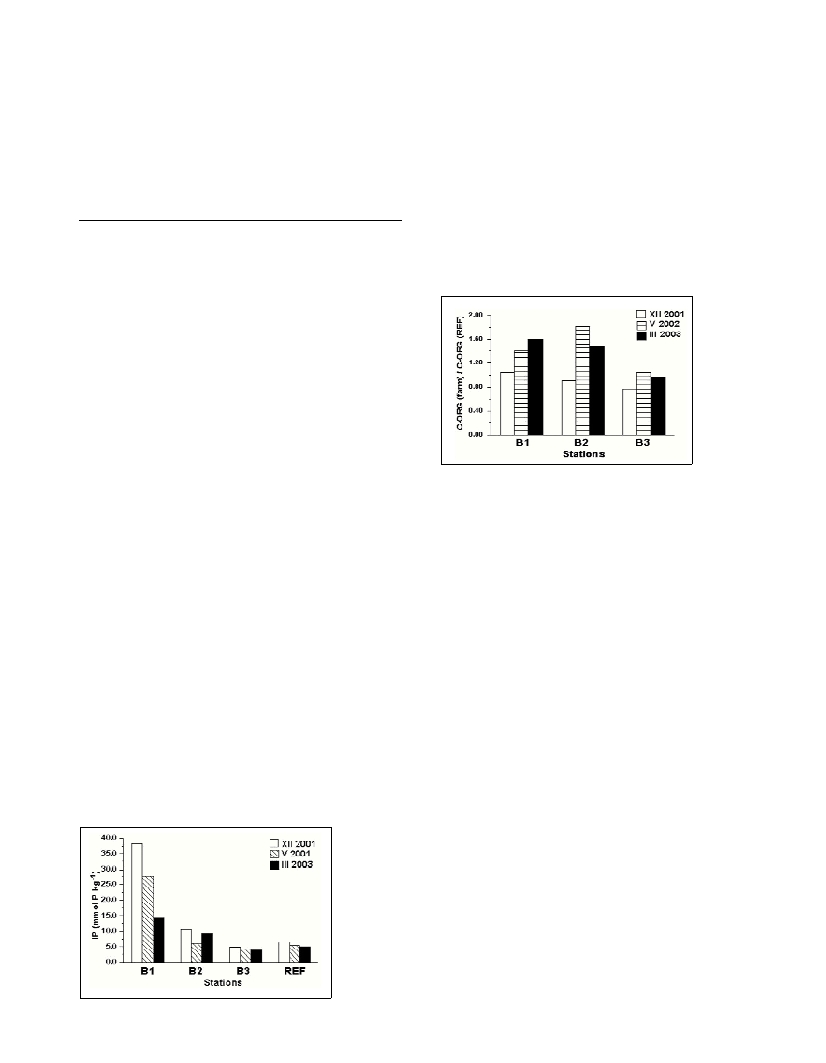Rapp. Comm. int. Mer Médit., 37,2004
222
FISH FARMING INFLUENCE ON PHYSICAL AND CHEMICAL PROPERTIES OF SEDIMENT
AND WATER COLUMN IN THE MIDDLE ADRIATIC
S. Matijevic*, G. Kuspilic, D. Bogner and A. Baric
Institute of Oceanography and Fisheries, P. O. Box 500, 21000 Split, Croatia - *dosen@izor.hr
Abstract
Changes of basic hydrographic and chemical properties of water column and sediment were investigated in a semi-enclosed area of the
middle Adriatic under the in?uence of fish farming. Changes were mainly expressed as water column enrichment with dissolved organic
nitrogen and phosphorus as well as occurrence of negative sediment redox potential, enhanced sediment inorganic phosphorus concentra-
tions and accumulation of sediment organic carbon.
Keywords: Adriatic Sea, sediments, phosphorus, organic carbon
Introduction
According to the trophic TRIX index (1) the coastal area of eastern
middle Adriatic can be characterized as oligotrophic. Due to low pri-
mary production and sedimentation of particulate organic matter, sed-
iment in this area has an oxidative surface layer 3-4 cm thick (positive
redox potential), inorganic phosphorus concentrations (2.94-38.62
mmol P kg
-1
) and organic carbon and total nitrogen content between
0.28-1.2 % and 0.02-0.12 % respectively. Strongly increasing fish
farming activities (especially tuna breeding) for the last years has
induced the development of a qualitative monitoring program of the
marine environment in affected areas. Results of investigated changes
of basic hydrographic and chemical parameters in water column and
sediment for one fish farm will be documented in this paper.
Materials and methods
Physical and chemical properties of sediment and water column
were investigated at fish farm located in a semi-enclosed bay in the
middle Adriatic during December 2001, May 2002 and March 2003.
Samples were taken at 3 stations at the breeding farm area (B1, B2
and B3) and at one reference station (REF; 500 meters distanced from
the farm). Investigated parameters in sediment were redox potential,
organic and inorganic phosphorus concentrations, organic carbon and
total nitrogen content. Parameters investigated in the bottom water
were temperature, salinity, visibility, suspended matter content, oxy-
gen saturation and dissolved inorganic and organic nutrient concentra-
tions.
Redox potential of sediment was measured “in situ” with Pt-elec-
trode after quinhyndrone calibration. Surface sediment cores for phos-
phorus concentration, organic carbon and nitrogen measurements
were frozen until the laboratory analysis. Analyses of phosphorus
content in surface sediment layer (0-2 cm) were done according to
Aspila (2). Organic carbon and total nitrogen sediment content were
analyzed on CHNS-O analyzer (CE Instruments). Hydographical and
chemical data were obtained by CTD-probe, classical Winkler titra-
tion and spectrophotometric determination (3).
Results and discussion
Redox-potential in the fish farming area were constantly more neg-
ative than in the sediment of reference station which indicates an oxi-
dation of settled organic matter with sulfate as the dominant electron
acceptor. Analyses of sediment phosphorus pool showed no signifi-
cant increase in organic fraction at the fish-farming stations, but the
concentrations of inorganic phosphorus (3.85 to 38.23 mmol P kg
-1
)
were up to 7 times higher than at reference station (Fig. 1), which
indicates that all phosphorus is in the inorganic form, probably bound-
ed as detrital and fish debris fraction (4).
Fig. 1.
Inorganic
sediment
phosphorus
concentrations
through
investigated
period.
Considering the role of seasonal variability of organic matter
decomposition processes at sediment organic carbon content, its accu-
mulation in sediment is calculated as ratio C-ORG at farm stations /
C-ORG at reference station (Fig. 2).
Fig. 2.
Calculated
ratios of C-org
(farm stations)
/ C-ORG
(reference
station)
through
investigated
period.
Ratios indicate a constant organic carbon accumulation in the most
enclosed station B1, while at stations B2 and B3 mineralization seems
to be more effective.
The main changes in the water column at the fish farming site were
strongly increased suspended matter content (relatively to the refer-
ence station), lowered visibility and oxygen saturation, as well as
enhanced dissolved organic nitrogen and phosphorus concentrations.
Conclusion
Investigations of fish farming in?uence on the marine environment
in the middle Adriatic showed negative changes of most basic param-
eters in sediment and water column. The high inorganic phosphorus
increase in sediment indicates on high downward ?ux of this element
from the water column to the sediment at fish farming areas.
References
1-Vollenweider, R.A., Giovanardi, F., Montanari, G., Rinaldi, A. 1998.
Characterization of the trophic conditions of marine coastal waters with
special reference to the NW Adriatic Sea: proposal for a trophic scale, tur-
bidity and generalized water quality index. Environmetrics, 9: 329-357.
2-Aspila K. I., Agemian, H. and Chau A. S. Y., 1976. A semi-automated
method for the determination of inorganic, organic and total phosphate in
sediments. Analyst, 101:187-197.
3-Grasshoff K., 1976. Methods of Seawater Analysis, Verlag Chemie,
Weinheim, 307 p.
4-Schenau S. J., De Lange G.J., 2001. Phosphorus regeneration vs. bur-
ial in sediments of the Arabian Sea. Mar. Chem.,75: 201-217.

